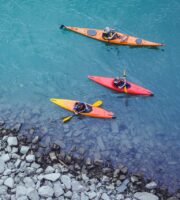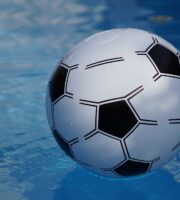Sappboarding is a relatively young sport, but it has already gained a lot of popularity. And no wonder, because SUP is multifunctional. It can be used to surf the waves, for a simple boat ride or even for yoga. In addition, the beginner will not be difficult to learn how to stand on a sapboard, and for training you do not need to go far to Hawaii, just find any body of water nearby and, of course, have the desire to ride.
A little history
SUP stands for Stand Up Paddle. Thus, sapboarding is a kind of surfing, respectively, and the history of sapboarding traces back to surfing, which appeared in Hawaii. The prototype of sap is considered to be the canoe used by the Hawaiian people. The canoe was steered while standing, using an oar to guide the boat downstream. The Hawaiians made “sapboards” of wood and quite long – the longest boards reached six meters in length and, of course, belonged to the royal family and nobles.
But today Paddle-board is making a new round in its development: the first company producing sapboards appeared in 2005, and in 2007 the first competitions in sapboarding were held. Sap is also convenient because it solves the problem of training in a full calm.
If you are interested in sapboarding
If you are interested in sapboarding, then feel free to grab your board and look for the nearest body of water. Sapboarding does not require waves or special weather (some sapboarders ride even in winter!); both a calm lake surface and a river with a slow current will do. Having lowered the board on the water, you need to lie down on it and swim away from the shore a little, then get up on your knees and, feeling the balance, try to get to your feet. Take an oar and, slowly paddling, enjoy the views and tranquility.
Of course, falls are not uncommon at first, but don’t be afraid. First you have to get on your board yourself and then go for your paddle. Just make sure in advance that your paddle does not sink.
Improving your skills, you can learn how to steer the sapboard and on the waves, or go for a hike on the river, or, having learned to keep your balance, do various tricks and even do yoga.
How to choose
But before you get on the water, one of the most important topics is the choice of equipment. We will try to outline the possible options of boards and accessories for sapboarding, as well as describe their advantages and disadvantages.
First of all SUPs
Let’s take a closer look at the characteristics of the board.
Sapboard width varies from 65 cm to 1 meter, and length from 3 to 4.5 meters. Hard sapboards use the lightest materials: fiberglass, wood, resin or carbon. Of course, the lightest boards are made of carbon, but they are also the most expensive. A separate category – inflatable SUP-boards. What type of board to choose, rigid or inflatable – it is up to everyone, but the advantages of inflatable boards are their compactness: you can easily take a board with you, it fits in a regular backpack and is easily stowed in the trunk of a car; and relative cheapness of inflatable boards in comparison with rigid ones.
Rigid sapboards, whether they are fiberglass, wood, or carbon, cost an order of magnitude more than any inflatable board. But it’s likely that any rider will want to try riding different saps made of different materials, including rigid saps. In any case, the sapboard market is overflowing with different boards for all tastes.
Sapboard paddles are usually about 20 cm longer than the rider’s height and as well as sapboards, they can be made from different materials: carbon, wood, aluminum. Of course, the most expensive and lightest paddles are made of carbon.
Lish, or safety leash, is necessary for most beginners, as it helps not to lose the board in case of a fall. As a rule, it should be 30 cm longer than a board.
Also among the accessories for a board it is worth mentioning different fins that help to stay on the water more stable. The fins are made of different materials and have different shapes. Thus, you can choose the style of riding for every taste. Today there is even a fin with an electric motor that is attached to the sipboard instead of the usual fin and is controlled remotely, using a remote control. When using such a fin with an electric motor, you will only need to use the paddle as a “steering wheel”; all that remains is to enjoy the water ride.







